Engage NY Eureka Math 4th Grade Module 5 Lesson 7 Answer Key
Eureka Math Grade 4 Module 5 Lesson 7 Problem Set Answer Key
Each rectangle represents 1.
Question 1.
The shaded unit fractions have been decomposed into smaller units. Express the equivalent fractions in a number sentence using multiplication. The first one has been done for you.
a. 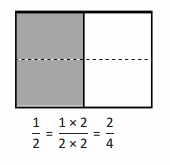
Answer:
1/2 = 2/4.
Explanation:
In the above-given question,
given that,
the shaded unit fractions have been decomposed into smaller units.
Express the equivalent fractions in a number sentence using multiplication.
1/2 = 1×2/2 x 2.
1x 2 = 2.
2 x 2 = 4.
2/4.
b. 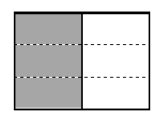
Answer:
1/3 = 3/6.
Explanation:
In the above-given question,
given that,
the shaded unit fractions have been decomposed into smaller units.
Express the equivalent fractions in a number sentence using multiplication.
1/3 = 1×3/3 x 2.
1x 3 = 3.
3 x 2 = 6.
3/6.
c. 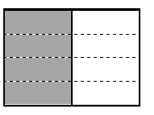
Answer:
1/4 = 4/8.
Explanation:
In the above-given question,
given that,
the shaded unit fractions have been decomposed into smaller units.
Express the equivalent fractions in a number sentence using multiplication.
1/4 = 1×4/4 x 2.
1x 4 = 4.
4 x 2 = 8.
4/8.
d. 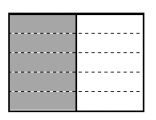
Answer:
1/5 = 5/10.
Explanation:
In the above-given question,
given that,
the shaded unit fractions have been decomposed into smaller units.
Express the equivalent fractions in a number sentence using multiplication.
1/5 = 1×5/5 x 2.
1x 5 = 5.
5 x 2 = 10.
5/10.
Question 2.
Decompose the shaded fractions into smaller units using the area models. Express the equivalent fractions in a number sentence using multiplication.
a. 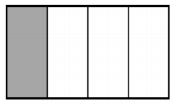
Answer:
1/2 = 2/8.
Explanation:
In the above-given question,
given that,
the shaded unit fractions have been decomposed into smaller units.
Express the equivalent fractions in a number sentence using multiplication.
1/2 = 1×2/4 x 2.
1x 2 = 2.
4 x 2 = 4.
2/8.
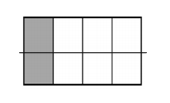
b. 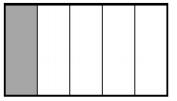
Answer:
1/2 = 2/10.
Explanation:
In the above-given question,
given that,
the shaded unit fractions have been decomposed into smaller units.
Express the equivalent fractions in a number sentence using multiplication.
1/2 = 1×2/2 x 5.
1x 2 = 2.
5 x 2 = 10.
2/10.
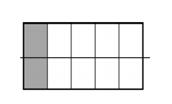
c. 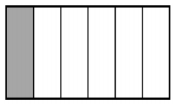
Answer:
1/3 = 3/18.
Explanation:
In the above-given question,
given that,
the shaded unit fractions have been decomposed into smaller units.
Express the equivalent fractions in a number sentence using multiplication.
1/3 = 1×3/3 x 6.
1x 3 = 3.
3 x 6 = 18.
3/18.
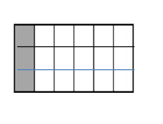
d. 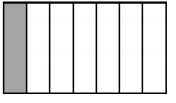
Answer:
1/3 = 3/21.
Explanation:
In the above-given question,
given that,
the shaded unit fractions have been decomposed into smaller units.
Express the equivalent fractions in a number sentence using multiplication.
1/3 = 1×3/3 x 7.
1x 3 = 3.
3 x 7 = 21.
3/21.

e. What happened to the size of the fractional units when you decomposed the fraction?
Answer:
The size of the fractional units decreases.
Explanation:
In the above-given question,
given that,
the size of the fractional units is decreased.
when the decomposing the fraction.
f. What happened to the total number of units in the whole when you decomposed the fraction?
Question 3.
Draw three different area models to represent 1 third by shading.
Decompose the shaded fraction into (a) sixths, (b) ninths, and (c) twelfths.
Use multiplication to show how each fraction is equivalent to 1 third.
a.Answer:
1/3 = 3/6.
Explanation:
In the above-given question,
given that,
the shaded unit fractions have been decomposed into smaller units.
Express the equivalent fractions in a number sentence using multiplication.
1/3 = 1×3/3 x 2.
1x 3 = 3.
3 x 2 = 6.
3/6.
b.Answer:
1/3 = 3/9.
Explanation:
In the above-given question,
given that,
the shaded unit fractions have been decomposed into smaller units.
Express the equivalent fractions in a number sentence using multiplication.
1/3 = 1×3/3 x 3.
1x 3 = 3.
3 x 3 = 9.
3/9.
c.Answer:
1/3 = 3/12.
Explanation:
In the above-given question,
given that,
the shaded unit fractions have been decomposed into smaller units.
Express the equivalent fractions in a number sentence using multiplication.
1/3 = 1×3/3 x 4.
1x 3 = 3.
3 x 4 = 12.
3/12.
Eureka Math Grade 4 Module 5 Lesson 7 Exit Ticket Answer Key
Draw two different area models to represent 1 fourth by shading.
Decompose the shaded fraction into (a) eighths and (b) twelfths.
Use multiplication to show how each fraction is equivalent to 1 fourth.
a.Answer:
1/4 = 4/8.
Explanation:
In the above-given question,
given that,
the shaded unit fractions have been decomposed into smaller units.
Express the equivalent fractions in a number sentence using multiplication.
1/4 = 1×4/4 x 2.
1x 4 = 4.
4 x 2 = 8.
4/8.

b.Answer:
1/4 = 4/12.
Explanation:
In the above-given question,
given that,
the shaded unit fractions have been decomposed into smaller units.
Express the equivalent fractions in a number sentence using multiplication.
1/4 = 1×4/4 x 3.
1x 4 = 4.
4 x 3 = 12.
4/12.
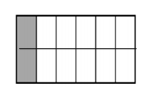
Eureka Math Grade 4 Module 5 Lesson 7 Homework Answer Key
Each rectangle represents 1.
Question 1.
The shaded unit fractions have been decomposed into smaller units. Express the equivalent fractions in a number sentence using multiplication. The first one has been done for you.
a. 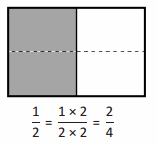
b. 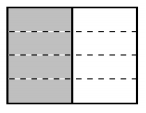
Answer:
1/4 = 4/8.
Explanation:
In the above-given question,
given that,
the shaded unit fractions have been decomposed into smaller units.
Express the equivalent fractions in a number sentence using multiplication.
1/4 = 1×4/2 x 4.
1x 4 = 4.
4 x 2 = 8.
4/8.
c. 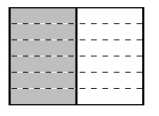
Answer:
1/6 = 6/12.
Explanation:
In the above-given question,
given that,
the shaded unit fractions have been decomposed into smaller units.
Express the equivalent fractions in a number sentence using multiplication.
1/6 = 1×6/6 x 2.
1x 6 = 6.
6 x 2 = 12.
6/12.
d. 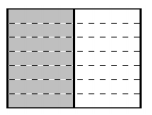
Answer:
1/7 = 7/14.
Explanation:
In the above-given question,
given that,
the shaded unit fractions have been decomposed into smaller units.
Express the equivalent fractions in a number sentence using multiplication.
1/7 = 1×7/7 x 2.
1x 7 = 7.
7 x 2 = 14.
7/14.
Question 2.
Decompose the shaded fractions into smaller units using the area models. Express the equivalent fractions in a number sentence using multiplication.
a. 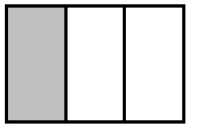
Answer:
1/2 = 2/6.
Explanation:
In the above-given question,
given that,
the shaded unit fractions have been decomposed into smaller units.
Express the equivalent fractions in a number sentence using multiplication.
1/2 = 1×2/2 x 3.
1x 2 = 2.
2 x 3 = 6.
2/6.
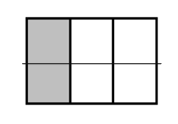
b. 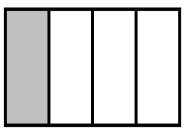
Answer:
1/4 = 4/8.
Explanation:
In the above-given question,
given that,
the shaded unit fractions have been decomposed into smaller units.
Express the equivalent fractions in a number sentence using multiplication.
1/4 = 1×4/4 x 2.
1x 4 = 4.
4 x 2 = 8.
4/8.

c. 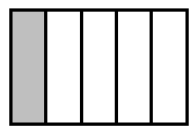
Answer:
1/5 = 5/10.
Explanation:
In the above-given question,
given that,
the shaded unit fractions have been decomposed into smaller units.
Express the equivalent fractions in a number sentence using multiplication.
1/5 = 1×5/5 x 2.
1x 5 = 5.
5 x 2 = 10.
5/10.

d. 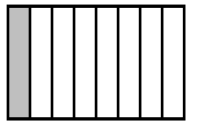
Answer:
1/8 = 8/16.
Explanation:
In the above-given question,
given that,
the shaded unit fractions have been decomposed into smaller units.
Express the equivalent fractions in a number sentence using multiplication.
1/8 = 1×8/8 x 2.
1x 8 = 8.
8 x 2 = 16.
8/16.
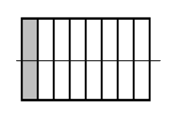
Question 3.
Draw three different area models to represent 1 fourth by shading.
Decompose the shaded fraction into (a) eighths, (b) twelfths, and (c) sixteenths.
Use multiplication to show how each fraction is equivalent to 1 fourth.
a.
Answer:
1/4 = 4/8.
Explanation:
In the above-given question,
given that,
the shaded unit fractions have been decomposed into smaller units.
Express the equivalent fractions in a number sentence using multiplication.
1/4 = 1×4/4 x 2.
1x 4 = 4.
4 x 2 = 8.
4/8.

b.Answer:
1/6 = 6/12.
Explanation:
In the above-given question,
given that,
the shaded unit fractions have been decomposed into smaller units.
Express the equivalent fractions in a number sentence using multiplication.
1/2 = 1×2/6 x 2.
1x 2 = 2.
6 x 2 = 12.
2/12.

c.
Answer:
1/4 = 4/16.
Explanation:
In the above-given question,
given that,
the shaded unit fractions have been decomposed into smaller units.
Express the equivalent fractions in a number sentence using multiplication.
1/4 = 1×4/4 x 4.
1x 4 = 4.
4 x 4 = 16.
4/16.
